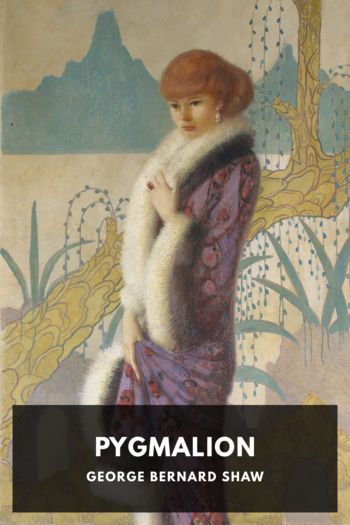Bulfinch’s Mythology Thomas Bulfinch (intellectual books to read TXT) 📖

- Author: Thomas Bulfinch
Book online «Bulfinch’s Mythology Thomas Bulfinch (intellectual books to read TXT) 📖». Author Thomas Bulfinch
The Black or Night Elves were a different kind of creatures. Ugly, long-nosed dwarfs, of a dirty brown color, they appeared only at night, for they avoided the sun as their most deadly enemy, because whenever his beams fell upon any of them they changed them immediately into stones. Their language was the echo of solitudes, and their dwelling-places subterranean caves and clefts. They were supposed to have come into existence as maggots produced by the decaying flesh of Ymir’s body, and were afterwards endowed by the gods with a human form and great understanding. They were particularly distinguished for a knowledge of the mysterious powers of nature, and for the runes which they carved and explained. They were the most skilful artificers of all created beings, and worked in metals and in wood. Among their most noted works were Thor’s hammer, and the ship Skidbladnir, which they gave to Freyr, and which was so large that it could contain all the deities with their war and household implements, but so skillfully was it wrought that when folded together it could be put into a side pocket.
Ragnarok, the Twilight of the GodsIt was a firm belief of the northern nations that a time would come when all the visible creation, the gods of Valhalla and Niffleheim, the inhabitants of Jotunheim, Alfheim, and Midgard, together with their habitations, would be destroyed. The fearful day of destruction will not, however, be without its forerunners. First will come a triple winter, during which snow will fall from the four corners of the heavens, the frost be very severe, the wind piercing, the weather tempestuous, and the sun impart no gladness. Three such winters will pass away without being tempered by a single summer. Three other similar winters will then follow, during which war and discord will spread over the universe. The earth itself will be frightened and begin to tremble, the sea leave its basin, the heavens tear asunder, and men perish in great numbers, and the eagles of the air feast upon their still quivering bodies. The wolf Fenris will now break his bands, the Midgard serpent rise out of her bed in the sea, and Loki, released from his bonds, will join the enemies of the gods. Amidst the general devastation the sons of Muspelheim will rush forth under their leader Surtur, before and behind whom are flames and burning fire. Onward they ride over Bifrost, the rainbow bridge, which breaks under the horses’ hoofs. But they, disregarding its fall, direct their course to the battlefield called Vigrid. Thither also repair the wolf Fenris, the Midgard serpent, Loki with all the followers of Hela, and the Frost giants.
Heimdall now stands up and sounds the Giallar horn to assemble the gods and heroes for the contest. The gods advance, led on by Odin, who engages the wolf Fenris, but falls a victim to the monster, who is, however, slain by Vidar, Odin’s son. Thor gains great renown by killing the Midgard serpent, but recoils and falls dead, suffocated with the venom which the dying monster vomits over him. Loki and Heimdall meet and fight till they are both slain. The gods and their enemies having fallen in battle, Surtur, who has killed Freyr, darts fire and flames over the world, and the whole universe is burned up. The sun becomes dim, the earth sinks into the ocean, the stars fall from heaven, and time is no more.
After this Alfadur (the Almighty) will cause a new heaven and a new earth to arise out of the sea. The new earth filled with abundant supplies will spontaneously produce its fruits without labor or care. Wickedness and misery will no more be known, but the gods and men will live happily together.
Runic LettersOne cannot travel far in Denmark, Norway, or Sweden without meeting with great stones of different forms, engraven with characters called Runic, which appear at first sight very different from all we know. The letters consist almost invariably of straight lines, in the shape of little sticks either singly or put together. Such sticks were in early times used by the northern nations for the purpose of ascertaining future events. The sticks were shaken up, and from the figures that they formed a kind of divination was derived.
The Runic characters were of various kinds. They were chiefly used for magical purposes. The noxious, or, as they called them, the bitter runes, were employed to bring various evils on their enemies; the favorable averted misfortune. Some were medicinal, others employed to win love, etc. In later times they were frequently used for inscriptions, of which more than a thousand have been found. The language is a dialect of the Gothic, called Norse, still in use in Iceland. The inscriptions may therefore be read with certainty, but hitherto very few have been found which throw the least light on history. They are mostly epitaphs on tombstones.
Gray’s ode on the Descent of Odin contains an allusion to the use of Runic letters for incantation:
“Facing to the northern clime,
Thrice he traced the Runic rhyme;
Thrice pronounced, in accents dread,
The thrilling verse that wakes the dead,
Till from out the hollow ground
Slowly breathed a sullen sound.”
The Skalds were the bards and poets of the nation, a very important class of men in all communities in an early stage of civilization. They are the depositaries of whatever historic lore there is, and it is their office to mingle something of intellectual gratification with the rude feasts of the warriors,





Comments (0)